Release Date :
Reference Number :
2023-SR07-014
Starting February 2022, the Philippine Statistics Authority (PSA) released the rebased Consumer Price Index (CPI) for all income households to base year 2018, from base year 2012 as announced in the press release number 2022-01 dated 04 January 2022. The CPI series for all income households for January 2022 onwards will be 2018-based.
Table A. Year-on-Year Inflation Rates, All Items in Percent
(2018=100)
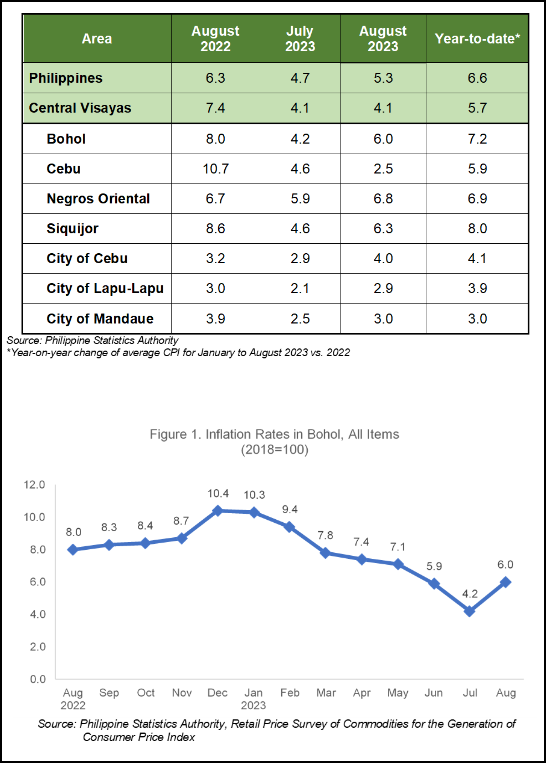
A. The Philippines
The Philippines’ headline inflation or overall inflation slightly spiked to 5.3 percent in August 2023 from 4.7 percent in July 2023, putting an end to the streak of decline for six consecutive months. The average Inflation Rate (IR) from January to August 2023 stood at 6.6 percent. In August 2022, the inflation rate was recorded at 6.3 percent.
B. Central Visayas
The inflation rate in Central Visayas remained at 4.1 percent, the same rate as in July 2023. In August 2022, the inflation rate was recorded at 7.4 percent.
C. Province of Bohol
1. Headline Inflation
Similar to the national trend, IR in Bohol rose to 6.0 percent from 4.2 in July 2023. The inflation rate in August 2022 was higher by 2.0 percentage points. The average inflation for the last eight months of the year stood at 7.2 percent. (Table A and Figure 1)
In comparison to national and regional figures, Bohol’s IR in August is higher by 0.7 percentage points than the national IR, and higher by
1.9 percentage points than the regional IR. (Table A)
1.1. Main Drivers to the Uptrend Trend of the Headline Inflation
The uptrend was mainly brought by Food and Non-alcoholic Beverages which recorded a higher inflation of 8.8 percent compared to 6.8 in the previous month; Housing, Water, Electricity, Gas and Other Fuels with 4.4 percent from 3.9 percent; Furnishings, Household Equipment and Routine Household Maintenance with 5.1 percent from 4.8 percent; Transport with -1.3 percent from -7.5 percent; and lastly, Recreation, Sports, and Culture with 3.2 percent from 2.4 percent.
In addition, the annual rates of the following commodities increased during the month:
- Alcoholic Beverages and Tobacco, 9.5 percent from 9.4 percent;
- Clothing and Footwear, 3.2 percent from 3.1 percent;
- Information and Communication, 0.7 percent from 0.6 percent;
- Personal Care, and Miscellaneous Goods and Services, 4.2 percent from 4.1 percent.
The commodity group Financial Services had zero percent annual growth.
1.2 Main Contributors to the Headline Inflation
The top three commodity groups that contributed to the August 2023 overall inflation of 6.0 percent were the following:
- Food and non-alcoholic beverages with 58.1 percent share or 3.5 percentage points;
- Housing, water, electricity, gas and other fuels at 16.2 percent share or 1.0 percentage points; and
- Restaurants and accommodation services at 8.0 percent share or 0.5 percentage point.
2. Food Inflation
Food inflation increased to 9.1 percent from 6.8 percent. In August 2022, Food inflation was lower at 6.0 percent.
2.1 Main Drivers to the Upward Trend of Food Inflation
Cereals and cereal products were the primary drivers of the higher food IR in August 2023, with 11.9 percent compared to 7.2 percent in the previous month.
Ranking second in the upward trend was Fish and other seafood with 3.5 percent from 0.6 percent in the previous month followed by Vegetables, tubers, plantains, cooking bananas and pulses with 24.4 percent from 20.1 percent in the previous month.
Higher year-on-year growth rates were also observed in the indices of the following food items:
- Meat and other parts of slaughtered land animals, 8.3 percent from 7.3 percent;
- Fruits and nuts, 2.9 percent from 0.0 percent; and
- Ready-made food and other food products n.e.c., 6.7 percent from 6.1 percent.
On the other hand, lower inflation rates during the month were noted in:
- Corn, 3.8 percent from 8.9 percent;
- Flour, bread, and other bakery products, pasta products, and other cereals, 8.2 percent from 9.0 percent;
- Milk, other dairy products and eggs, 7.6 percent from 8.8 percent;
- Oils and fats, 0.1 percent from 0.9 percent; and
- Sugar, confectionary and desserts, 1.1 percent from 19.9 percent.
2.2 Main Contributors to the Food Inflation
Food shared 58.1 percent or 3.49 percentage points to the overall inflation in August 2023. The following food groups were the top contributors to food inflation during the month:
- Cereals and cereal products, with 52.0 percent share or 4.73 percentage points;
- Vegetables, tubers, plantains, cooking bananas and pulses, with 19.0 percent share or 1.73 percentage points; and
- Meat and other parts of slaughtered land animals with 12.0 percent share or 1.10 percentage points.
Table B. Year-on-Year Inflation Rates in the Philippines, All Items,
In Percent
January 2019 - August 2023
(2018=100)
(2018=100)
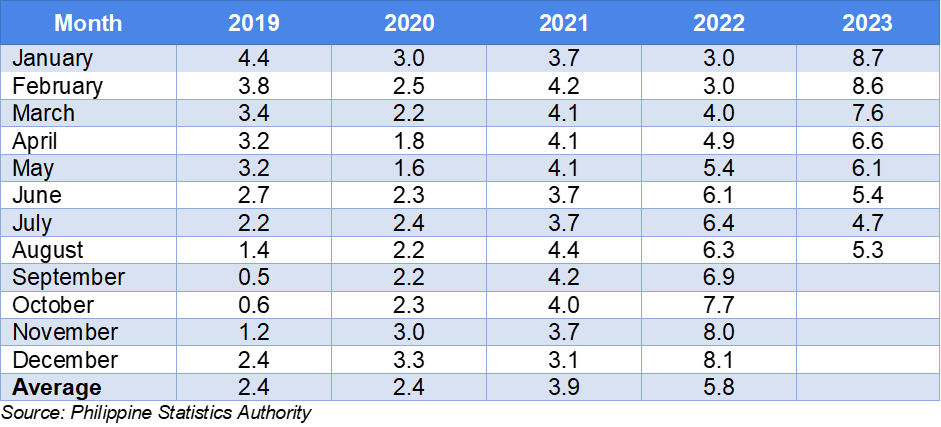
Table C. Year-on-Year Inflation Rates in Central Visayas, All Items
In Percent
January 2019 - August 2023
(2018=100)
(2018=100)
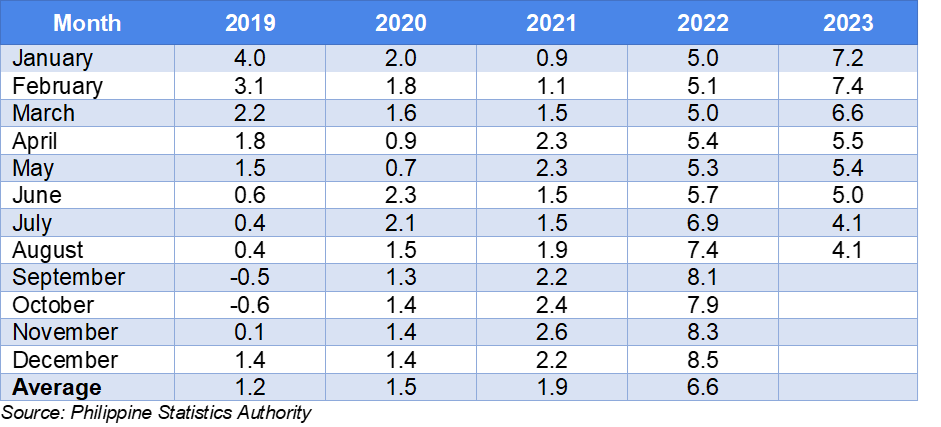
Table D. Year-on-Year Inflation Rates in Bohol, All Items
In Percent
January 2019 - August 2023
(2018=100)
(2018=100)
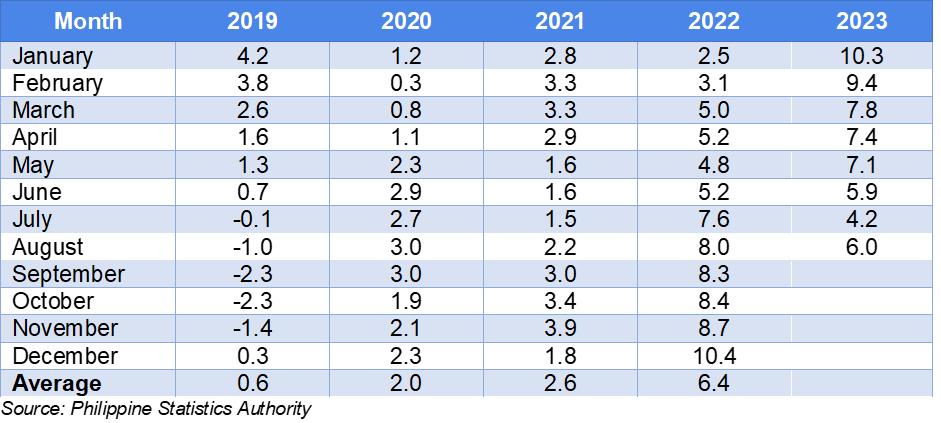
Table E. Inflation Rate by Commodity Group for All Income Households in Bohol: August 2022; June to August 2023
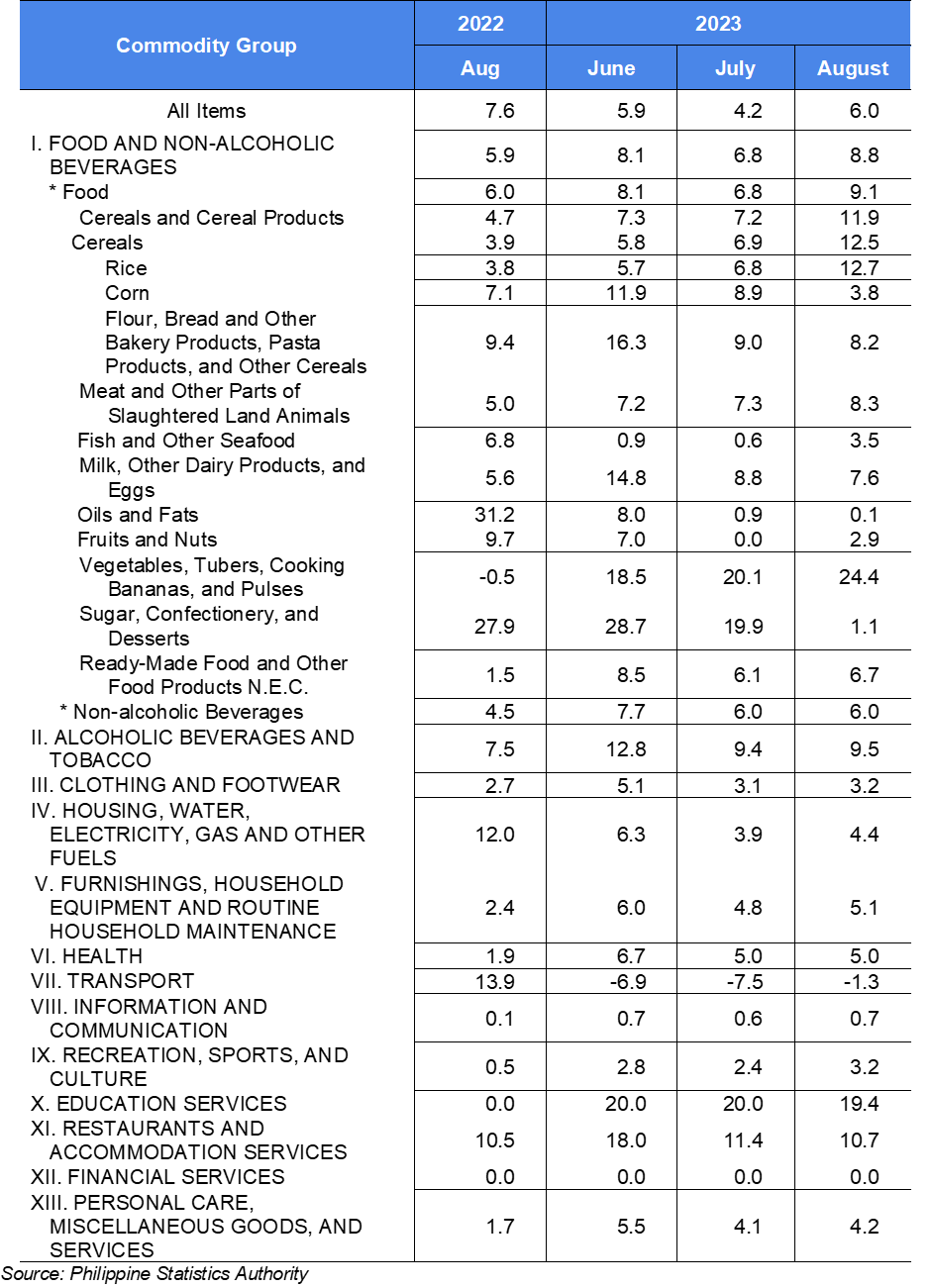
TECHNICAL NOTES
The Philippine Statistics Authority generates and publishes the monthly Consumer Price Index (CPI) based on a nationwide survey of prices for a given basket of goods and services. Two important indicators, the inflation rate and purchasing power of the peso (PPP), are derived from the CPI which are important in monitoring price stability and the value of the country’s currency.
The CPI is an indicator of the change in the average retail prices of a fixed basket of goods and services commonly purchased by households relative to a base year.
Retail Price is the price at which a commodity is sold for spot in small quantities for consumption.
Base Period/Base Year is the period, usually a year, at which the index number is set to 100. It is the reference point of the index number series.
Market Basket is a term used to refer to a sample of goods and services that are commonly purchased and bought by an average Filipino household.
Weight is a value attached to a commodity or group of commodities to indicate the relative importance of that commodity or group of commodities in the market basket.
Inflation Rate is the change in the CPI over a specific period of time (usually a month or a year). That is,

where:
CPI1 - is the CPI in the previous period
CPI2 - is the CPI in the current period
Headline Inflation is the rate of change in the weighted average prices of all goods and services in the CPI basket.
The Purchasing Power of the Peso (PPP) is a measure of the real value of the peso in a given period relative to a chosen reference period. It is computed by getting the reciprocal of the CPI and multiplying the result by 100. That is,

Prepared by:
FRED JORDAN MIKHAIL T. CARNICE (Sgd.)
PhilSys Focal Person (COSW)
Reviewed by:
VENUS P. GLORIA (Sgd.)
Statistical Analyst
Approved by:
JESSAMYN ANNE C. ALCAZAREN (Sgd.)
Chief Statistical Specialist
PSA Bohol

